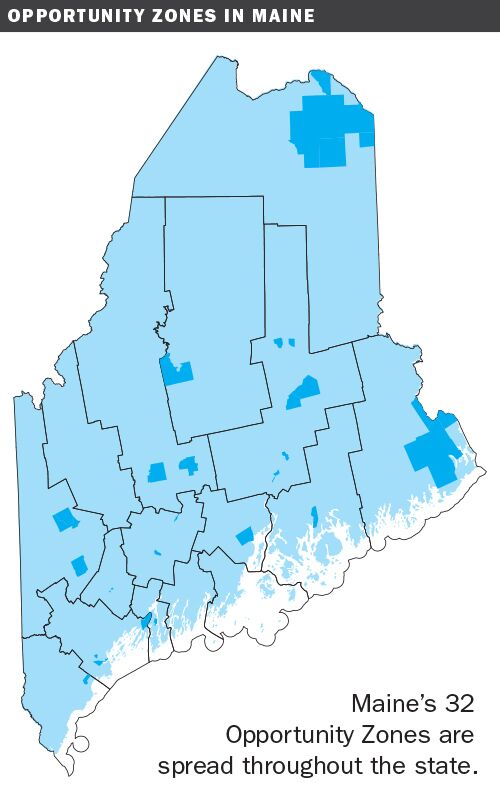Processing Your Payment
Please do not leave this page until complete. This can take a few moments.
- News
-
Editions
View Digital Editions
Biweekly Issues
- December 1, 2025
- Nov. 17, 2025
- November 03, 2025
- October 20, 2025
- October 6, 2025
- September 22, 2025
- + More
Special Editions
- Lists
- Viewpoints
-
Our Events
Event Info
Award Honorees
- Calendar
- Biz Marketplace
Law firms are jumping into the new development field created by 'Opportunity Zones'
 Photo / Tim Greenway
Rob Ravenelle, left, and Kris Eimicke, tax specialists at Pierce Atwood in Portland, say the new federal Opportunity Zones have the potential for significant impact.
Photo / Tim Greenway
Rob Ravenelle, left, and Kris Eimicke, tax specialists at Pierce Atwood in Portland, say the new federal Opportunity Zones have the potential for significant impact.

It's rare that the word “exciting” and tax law are joined in the same sentence, but excited is what everyone from attorneys to developers are about the new Opportunity Zone tax benefit.
“I think it's really exciting,” says Kris Eimicke, a tax law and economic development attorney at Pierce Atwood in Portland. “It has the potential for significant impact.”
Drew Anderson, real estate director at Murray Plumb & Murray in Portland, says there's more attention on the new law than he's seen on a tax rule in a long time. “It's a new toy, and people are pretty excited.”
Kevin Mattson, of Dirigo Capital Advisors, a partner on what may be the first Opportunity Zone project in the country, feels the same way.
“The impact this is going to have is really exciting,” he says.
The program is new, the rules aren't final, and developers and investors are very interested in the possibilities. As the front line of any commercial development, law firms that have a focus on real estate development are scrambling to stay on top of the program.
The Opportunity Zone tax benefit, which came out of the federal tax overhaul, is designed to encourage development in designated zones across the U.S. that are considered low-income or in need of development. Maine's 32 zones were announced in May. There are 8,761 zones across the U.S. and its territories.
Proposed rules were released by the U.S. Treasury Oct. 19 and may be finalized by the end of the year after a 60-day comment period.
The program allows capital gains to be put into a fund for a designated Opportunity Zone within six months of the gains being realized. Once that's done, they're not taxed until Dec. 31, 2026. The longer the property is held, the more the tax benefit. After five years, 10% of the property would be excluded from taxes; that rises to 15% after seven years. After 10 years, all of the gains are tax-free.
A special fund must be set up for a zone project, usually in the form of an LLC.
The money is expected to be used to redevelop a struggling property or business. Money rolled back into the fund can be reinvested into the same building or business, or others in the same zone.
The U.S. Treasury has estimated $100 billion may pour into the program.
Figuring it out
Anderson was the legal advisor on what may be one of the first Opportunity Zone projects in the country, the redevelopment of 333 Water St., in Augusta.
“I guess that makes me an expert,” he says with a laugh.
The former Odd Fellows Hall is in the Opportunity Zone that extends from Augusta's western border to the Kennebec River, bounded by Western Avenue to the south and Bond Brook to the north — which includes all of the city's downtown and a huge part of its historic residential area.
When the project was brought to Anderson, “I tackled it without much choice,” he says. “Since then, I've been doing some research.”
He says he's not different from attorneys at other firms. “We're just starting to grapple with it. More and more clients are asking about it, and we're having to figure it out.”
Sorting the nuances
“This building could've been an Opportunity Zone project,” Eimicke says as he sits in Pierce Atwood's fifth-floor conference room on Portland's waterfront.
When the zones were announced, some questioned the fact that part of Portland's active peninsula commercial district was included with places like huge swaths of Aroostook and Washington counties, Millinocket, downtown Augusta and other areas that seem more obviously distressed.
Sorting out the nuances of the new program is part of what attorneys advising investors and developers do.
“I wasn't surprised at all by the [Portland] designation,” says Eimicke. “There's a lot of development here, but there's potential for a lot more.”
It's not only about development property, but developing business, adds Rob Ravenelle, head of the federal income tax practice at Pierce Atwood.
“People don't necessarily understand how it works until you explain it,” says Ravenelle. But, he adds, “It's not overly complicated,” and that makes it appealing to investors.
Eimicke says he's already working with a couple of Opportunity Zone projects, and both attorneys are fielding frequent questions.
“Nobody wants to be left behind,” Eimicke says. “They want to understand how it helps them and their projects.”
Only limited by geography
Developer Mattson says one of the “great things” about the program is that it's a tax benefit, not a tax credit, like most other programs.
“No one's writing a check,” he says.
He predicts the program will have more economic impact than Community Development Block grants, the venerable federal Housing and Urban Development program that has been pumping money into low-income areas in need of development since 1974.
One of the intriguing things about the program, and what makes it different from government-funded and tax credit programs, Mattson says, is that it's for individual projects and fueled by capital investment. He says that over the past few years, huge capital gains have built up, and investors are looking for places to funnel the money.
Eimicke, of Pierce Atwood, says, “What separates this from those other programs is the scale. It's only limited by geography, it's not limited by amount of money.”
It's similar in many ways to the New Markets Tax Credit program, which gives tax incentives to developers investing in distressed areas, Ravenelle says. That makes it easy for those investing to understand it, but he, too, stresses the scale difference.
“Only 25% of New Markets [zones] are qualified Opportunity Zones,” he says.
Caveats and optimism
Murray, Plumb & Murray's Anderson suggests clients wait until the final regulations come out before making decisions related to the program.
“It's up for comment and some things may change,” he says. “They have to put some meat to the bones.”
While property development requires a legal opinion, Anderson says, “I always encourage clients to have an accountant take a look.”
Eimicke and Ravenelle also say investor enthusiasm is tempered by some caveats. For instance, not all development, even in qualified Opportunity Zone, is a good fit.
“It has to make economic sense, even before the tax pieces come together,” says Ravenelle.
Anderson also says areas that already have some development spark are more likely to see more of it through the program. Short-term economics are as important as the long-term investment.
“You still have to fill it with tenants who pay rent,” he says. “If you're the first one in a blighted area, you buy the property and fix it up, you still have to consider what kind of tenants you're going to get.”
Developer Mattson says the program isn't the reason to do a development. “It's part of the basket of tools,” he says.
He says most developers combine many economic drivers, particularly historic and low-income tax credits, CDBGs, tax increment financing districts and the New Markets tax credit. But he says it's an important tool — the one piece that can be the tipping point.
Eimicke and Ravenelle say they're proceeding with clients on Opportunity Zone projects.
“I think we can rely on the proposed regulations,” says Ravanelle, adding any changes probably won't be substantial.
“It's not likely the rules are going to be less investor-friendly,” Eimicke adds.
Opportunity Zones: The who, what, where and why
The Opportunity Zone program, approved in in May as part of December's federal tax overhaul, was devised as a way to funnel investment capital into areas that are ripe for rehabilitation. Proposed rules from the U.S. Treasury Department were released Oct. 19 and are expected to be finalized by the end of the year.
What is it?: The Opportunity Zone Program is a tax benefit, not a credit — there's no upfront government money. Capital gains from selling a property or asset can be formed into an Opportunity Zone fund within six months of the gain. Tax benefits are realized the longer the property is held.
How does the money part work?: At least 90% of a fund, which is set up for the specific zone, must be rolled into development of a property or business in the zone. Gains must be invested within six months of when they're realized, and taxes on prior gains invested into an Opportunity Zone fund are deferred until 2026. The tax is forgiven fully if the investor holds the property for 10 years. If the property is held for five years, taxes exclude 10% of the property; if it's held for seven years, 15% is excluded. Money that goes back into the fund must be used for that project, or to develop other projects within the same zone.
How much money are we talking about?: The U.S. Treasury estimates $100 billion will be invested into Opportunity Zones.
What are the zones?: There are 32 zones in Maine, ranging from Portland's waterfront and part of downtown, to a huge swath of the west side of Augusta, to a large portion of Washington County. All of the state's urban areas are represented, including parts of Lewiston-Auburn, Bangor, Brunswick, South Portland and Westbrook, as well as many smaller communities. A full map and list can be found at www.maine.gov/decd. In the U.S., zones have been designated in 8,761 communities.
Sources: maine.gov/decd; home.treasury.gov; media reports
Mainebiz web partners
Related Content

The Giving Guide
The Giving Guide helps nonprofits have the opportunity to showcase and differentiate their organizations so that businesses better understand how they can contribute to a nonprofit’s mission and work.
Learn More
Work for ME
Work for ME is a workforce development tool to help Maine’s employers target Maine’s emerging workforce. Work for ME highlights each industry, its impact on Maine’s economy, the jobs available to entry-level workers, the training and education needed to get a career started.
Learn More
Groundbreaking Maine
Whether you’re a developer, financer, architect, or industry enthusiast, Groundbreaking Maine is crafted to be your go-to source for valuable insights in Maine’s real estate and construction community.
Learn more-
The Giving Guide
The Giving Guide helps nonprofits have the opportunity to showcase and differentiate their organizations so that businesses better understand how they can contribute to a nonprofit’s mission and work.
-
Work for ME
Work for ME is a workforce development tool to help Maine’s employers target Maine’s emerging workforce. Work for ME highlights each industry, its impact on Maine’s economy, the jobs available to entry-level workers, the training and education needed to get a career started.
-
Groundbreaking Maine
Whether you’re a developer, financer, architect, or industry enthusiast, Groundbreaking Maine is crafted to be your go-to source for valuable insights in Maine’s real estate and construction community.
ABOUT
NEW ENGLAND BUSINESS MEDIA SITES
No articles left
Get access now
In order to use this feature, we need some information from you. You can also login or register for a free account.
By clicking submit you are agreeing to our cookie usage and Privacy Policy
Already have an account? Login
Already have an account? Login
Want to create an account? Register
Get access now
In order to use this feature, we need some information from you. You can also login or register for a free account.
By clicking submit you are agreeing to our cookie usage and Privacy Policy
Already have an account? Login
Already have an account? Login
Want to create an account? Register











Comments